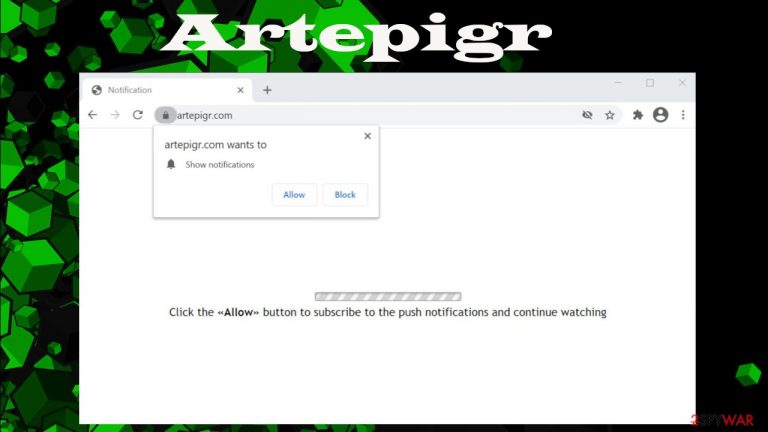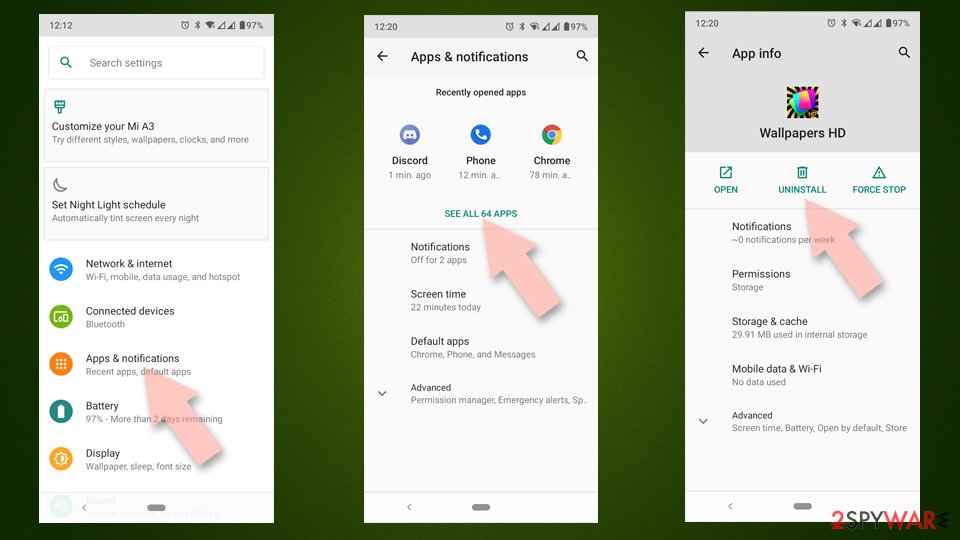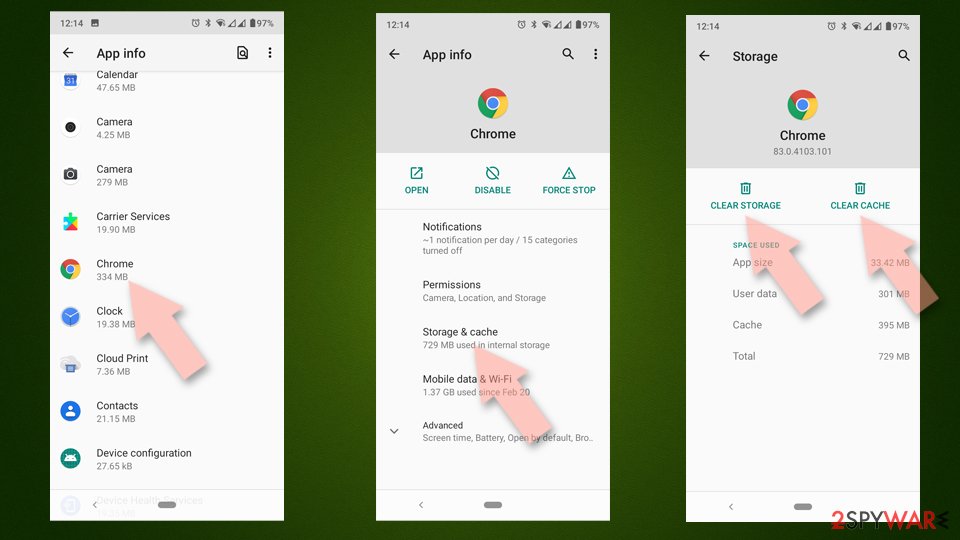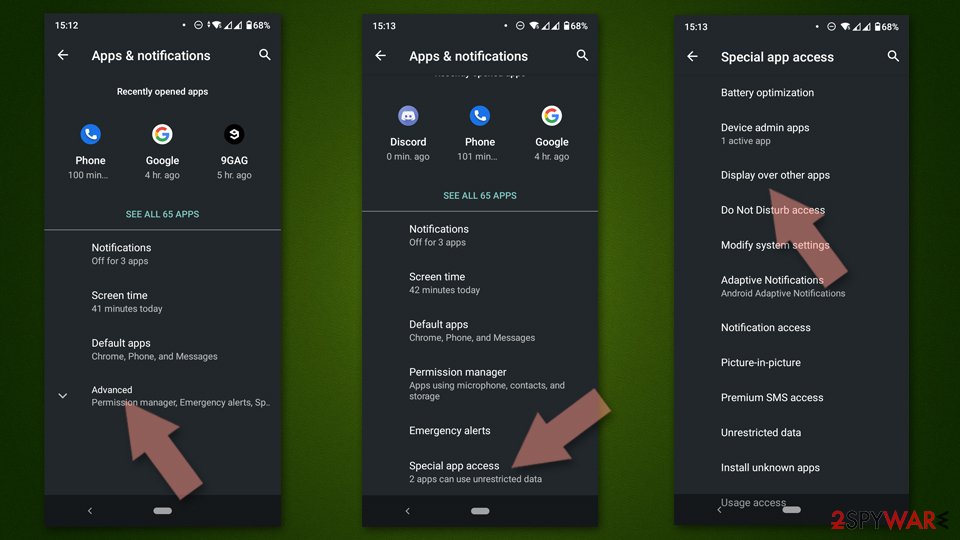Artepigr (Easy Removal Guide) - Chrome, Firefox, IE, Edge
Artepigr Removal Guide
What is Artepigr?
Artepigr – a webpage that seeks to show you intrusive ads and reroutes online traffic to shady sites

Artepigr is a push notification website that tries to trick its visitors into clicking the Allow button. When you subscribe to its notifications, you will start receiving irritating ads directly on your cell phone screen or PC desktop. Whether you're redirected to this portal or visited it willingly, please don't press the Allow button. If that happens you enable additional content from third-party pages and this particular redirection site.
Many sites as Artepigr.com push notification virus try to trick people by showing various error messages, that may include proving that you're not a robot, continuing watching some imaginary video, revealing some hidden content, or use other mischievous social-engineering techniques.
People don't usually visit sites such as Viralnewsobserver virus, Maincaptchasource virus, AllHugeNews virus, and alike, willingly. They are redirected to them when adware or other potentially unwanted programs[1] (PUPs) installed on their devices. In this article, you'll find a brief summary of this intruder, its distribution techniques, and removal options.
| name | Artepigr |
|---|---|
| type | Adware, push notification virus, PUP |
| IP address | 104.21.56.207 |
| Symptoms | Redirects to unknown, questionable webpages. Ads appearing even when browsers are closed, slower device performance |
| Risks | Deceptive ads could redirect to malicious portals, same might happen without clicking any buttons |
| Distribution | Freeware bundles, deceptive ads, fake Flash Player updates/installs |
| Removal | To keep your device safe and eliminate any threats you should have a trustworthy anti-malware tool watching your back |
| System Repair | To fix any corrupted system files/settings and delete tracking cookies from hazardous sites, use the all-in-one FortectIntego system tune-up software |
As we've mentioned before, if you didn't type in Artepigr.com manually into your browser, but the push notification page is still opened once in a while, that means you have adware, browser hijacker, or other PUP installed on your device. The good news is that these types of programs aren't as hazardous as malware.
But they still might endanger your privacy and security. Artepigr ads could bring the most harm to you and your computer. These deceptive ads might portray some imaginary breaking news, amazing software/hardware deals, and other misleading content.
PUP operators don't care for their user safety. Therefore, if a deceptive Artepigr ad is clicked on, you could be redirected to various malicious pages, which would try to draw out your private details, involve you in different scams, push other PUP installations, and other shenanigans.
Furthermore, PUPs are capable of gathering non-personal information,[2] such as the device and browser details, IP addresses, geolocations, search inquiries, used apps, visited sites, etc. These details are used to show you personalized apps, but if they would fall into the wrong hands, you could become a victim of a cybercrime.
Trustworthy anti-malware software, such as SpyHunter 5Combo Cleaner or Malwarebytes could prevent you from visiting such pages and block various PUPs and malware from infecting your devices. Such tools should be used to safely remove Artepigr with all of its associated files. If you leave any of the pieces running, PUP symptoms might annoy you still until the intruder is fully terminated.
Powerful system tools or PC repair applications should be used after Artepigr removal to erase it from the Registry and restore other core files and settings. IT experts[3] highly recommend using the all-in-one FortectIntego system diagnostic tool that will take care of system-related issues and eliminate any tracking cookies.

Stay attentive when installing new software
Potentially unwanted program operators use various tricks to distribute their junkware. One of the most popular methods is software bundling. Try to be cautious when downloading new software and do it directly from its developers or official distributors, or you might end up with an adware or other PUP infection.
Software or freeware bundles are usually downloaded from third-party vendors that have numerous apps available. These packs contain installers for more than one app and all of them are preselected for installation. Thus if you rush through it, all of them end up on your device.
The key is to choose the Advanced or Custom (or alike) installation method and look through all the apps that would have been installed if you'd have chosen otherwise. Deselect all untrustworthy, unknown, unnecessary software and install only the one you initially wanted.
Remove Artepigr virus to get rid of the annoying spam notifications
Push notifications are a legitimate feature that lets you stay in the know. But threat actors tend to misuse it to bombard victims with tons of deceptive ads. Therefore, you should accept these notifications only from well-known sources, like your favorite news site, online store, and alike, not the Artepigr.com or different PUP page that triggers redirects and advertisements.
If your device got infected the good news is that it can be virus-free within a couple of minutes. To remove Artepigr with its deceptive ads and adware causing redirects to similar pages you have to use dependable anti-malware software. Afterward, run system diagnostics to eliminate all tracking cookies and maintain system files and settings in order.
In some cases, you will need to get your hands dirty to finish Artepigr removal. You will have to manually delete its notifications from the browser of your choice. Below you'll find our free step-by-step instructions for Chrome, Firefox, and all other browsers that this push notification virus might have affected.
You may remove virus damage with a help of FortectIntego. SpyHunter 5Combo Cleaner and Malwarebytes are recommended to detect potentially unwanted programs and viruses with all their files and registry entries that are related to them.
Getting rid of Artepigr. Follow these steps
Uninstall from Windows
Instructions for Windows 10/8 machines:
- Enter Control Panel into Windows search box and hit Enter or click on the search result.
- Under Programs, select Uninstall a program.

- From the list, find the entry of the suspicious program.
- Right-click on the application and select Uninstall.
- If User Account Control shows up, click Yes.
- Wait till uninstallation process is complete and click OK.

If you are Windows 7/XP user, proceed with the following instructions:
- Click on Windows Start > Control Panel located on the right pane (if you are Windows XP user, click on Add/Remove Programs).
- In Control Panel, select Programs > Uninstall a program.

- Pick the unwanted application by clicking on it once.
- At the top, click Uninstall/Change.
- In the confirmation prompt, pick Yes.
- Click OK once the removal process is finished.
Delete from macOS
Remove items from Applications folder:
- From the menu bar, select Go > Applications.
- In the Applications folder, look for all related entries.
- Click on the app and drag it to Trash (or right-click and pick Move to Trash)

To fully remove an unwanted app, you need to access Application Support, LaunchAgents, and LaunchDaemons folders and delete relevant files:
- Select Go > Go to Folder.
- Enter /Library/Application Support and click Go or press Enter.
- In the Application Support folder, look for any dubious entries and then delete them.
- Now enter /Library/LaunchAgents and /Library/LaunchDaemons folders the same way and terminate all the related .plist files.

Remove from Microsoft Edge
Delete unwanted extensions from MS Edge:
- Select Menu (three horizontal dots at the top-right of the browser window) and pick Extensions.
- From the list, pick the extension and click on the Gear icon.
- Click on Uninstall at the bottom.

Clear cookies and other browser data:
- Click on the Menu (three horizontal dots at the top-right of the browser window) and select Privacy & security.
- Under Clear browsing data, pick Choose what to clear.
- Select everything (apart from passwords, although you might want to include Media licenses as well, if applicable) and click on Clear.

Restore new tab and homepage settings:
- Click the menu icon and choose Settings.
- Then find On startup section.
- Click Disable if you found any suspicious domain.
Reset MS Edge if the above steps did not work:
- Press on Ctrl + Shift + Esc to open Task Manager.
- Click on More details arrow at the bottom of the window.
- Select Details tab.
- Now scroll down and locate every entry with Microsoft Edge name in it. Right-click on each of them and select End Task to stop MS Edge from running.

If this solution failed to help you, you need to use an advanced Edge reset method. Note that you need to backup your data before proceeding.
- Find the following folder on your computer: C:\\Users\\%username%\\AppData\\Local\\Packages\\Microsoft.MicrosoftEdge_8wekyb3d8bbwe.
- Press Ctrl + A on your keyboard to select all folders.
- Right-click on them and pick Delete

- Now right-click on the Start button and pick Windows PowerShell (Admin).
- When the new window opens, copy and paste the following command, and then press Enter:
Get-AppXPackage -AllUsers -Name Microsoft.MicrosoftEdge | Foreach {Add-AppxPackage -DisableDevelopmentMode -Register “$($_.InstallLocation)\\AppXManifest.xml” -Verbose

Instructions for Chromium-based Edge
Delete extensions from MS Edge (Chromium):
- Open Edge and click select Settings > Extensions.
- Delete unwanted extensions by clicking Remove.

Clear cache and site data:
- Click on Menu and go to Settings.
- Select Privacy, search and services.
- Under Clear browsing data, pick Choose what to clear.
- Under Time range, pick All time.
- Select Clear now.

Reset Chromium-based MS Edge:
- Click on Menu and select Settings.
- On the left side, pick Reset settings.
- Select Restore settings to their default values.
- Confirm with Reset.

Remove from Mozilla Firefox (FF)
Remove dangerous extensions:
- Open Mozilla Firefox browser and click on the Menu (three horizontal lines at the top-right of the window).
- Select Add-ons.
- In here, select unwanted plugin and click Remove.

Reset the homepage:
- Click three horizontal lines at the top right corner to open the menu.
- Choose Options.
- Under Home options, enter your preferred site that will open every time you newly open the Mozilla Firefox.
Clear cookies and site data:
- Click Menu and pick Settings.
- Go to Privacy & Security section.
- Scroll down to locate Cookies and Site Data.
- Click on Clear Data…
- Select Cookies and Site Data, as well as Cached Web Content and press Clear.

Reset Mozilla Firefox
If clearing the browser as explained above did not help, reset Mozilla Firefox:
- Open Mozilla Firefox browser and click the Menu.
- Go to Help and then choose Troubleshooting Information.

- Under Give Firefox a tune up section, click on Refresh Firefox…
- Once the pop-up shows up, confirm the action by pressing on Refresh Firefox.

Remove from Google Chrome
Delete malicious extensions from Google Chrome:
- Open Google Chrome, click on the Menu (three vertical dots at the top-right corner) and select More tools > Extensions.
- In the newly opened window, you will see all the installed extensions. Uninstall all the suspicious plugins that might be related to the unwanted program by clicking Remove.

Clear cache and web data from Chrome:
- Click on Menu and pick Settings.
- Under Privacy and security, select Clear browsing data.
- Select Browsing history, Cookies and other site data, as well as Cached images and files.
- Click Clear data.

Change your homepage:
- Click menu and choose Settings.
- Look for a suspicious site in the On startup section.
- Click on Open a specific or set of pages and click on three dots to find the Remove option.
Reset Google Chrome:
If the previous methods did not help you, reset Google Chrome to eliminate all the unwanted components:
- Click on Menu and select Settings.
- In the Settings, scroll down and click Advanced.
- Scroll down and locate Reset and clean up section.
- Now click Restore settings to their original defaults.
- Confirm with Reset settings.

Delete from Safari
Remove unwanted extensions from Safari:
- Click Safari > Preferences…
- In the new window, pick Extensions.
- Select the unwanted extension and select Uninstall.

Clear cookies and other website data from Safari:
- Click Safari > Clear History…
- From the drop-down menu under Clear, pick all history.
- Confirm with Clear History.

Reset Safari if the above-mentioned steps did not help you:
- Click Safari > Preferences…
- Go to Advanced tab.
- Tick the Show Develop menu in menu bar.
- From the menu bar, click Develop, and then select Empty Caches.

Uninstall from Android
Uninstall unwanted programs from Android device:
- Go to Settings -> Apps/Applications.
- Expand the full list of the installed apps.
- Scroll through the list and tap on a suspicious application once.
- Tap on it and select Uninstall.

- Reboot the device.
Clear Storage and data files on Android from Google Chrome or other apps:
- Go to Settings > Apps/Applications.
- Expand the full list of the installed apps.
- Tap on Chrome and select Storage & cache.
- Clear storage and clear cache of the app.

If you are seeing ads on top of other apps but are not sure what is causing it, perform the following steps:
- Go to Apps/Applications.
- Tap Advanced.
- Select Special App access.
- Tap on Display over other apps.

- Eliminate apps with these access rights enabled.
Stop browser notifications
Remove unwanted notifications from Google Chrome (desktop):
- Open Google Chrome browser and go to Menu > Settings.
- Scroll down and click on Advanced.
- Locate Privacy and security section and pick Site Settings > Notifications.

- Look at the Allow section and look for a suspicious URL.
- Click the three vertical dots next to it and pick Block. This should remove unwanted notifications from Google Chrome.

Remove unwanted notifications from Google Chrome (Android):
- Open Google Chrome and tap on Settings (three vertical dots).
- Select Notifications.
- Scroll down to the Sites section.
- Locate the unwanted URL and toggle the button to the left (Off setting).

Remove unwanted notifications from Mozilla Firefox:
- Open Mozilla Firefox and go to Menu > Options.
- Click on Privacy & Security section.
- Under Permissions, you should be able to see Notifications. Click the Settings button next to it.

- In the Settings – Notification Permissions window, click on the drop-down menu by the URL in question.
- Select Block and then click on Save Changes. This should remove unwanted notifications from Mozilla Firefox.

Remove unwanted notifications from Safari:
- Click on Safari > Preferences…
- Go to the Websites tab and, under General, select Notifications.
- Select the web address in question, click the drop-down menu and select Deny.

Remove unwanted notifications from MS Edge:
- Open Microsoft Edge, and click the Settings and more button (three horizontal dots) at the top-right of the window.
- Select Settings and then go to Advanced.
- Under Website permissions, pick Manage permissions and select the URL in question.

- Toggle the switch to the left to turn notifications off on Microsoft Edge.

Remove unwanted notifications from MS Edge (Chromium):
- Open Microsoft Edge, and go to Settings.
- Select Site permissions.
- Go to Notifications on the right.
- Under Allow, you will find the unwanted entry.
- Click on More actions and select Block.

Remove unwanted notifications from Internet Explorer:
- Open Internet Explorer, and click on the Gear icon at the top-right of the window.
- Select Internet options and go to the Privacy tab.
- In the Pop-up Blocker section, click on Settings.
- Locate web address in question under Allowed sites and pick Remove.

After uninstalling this potentially unwanted program (PUP) and fixing each of your web browsers, we recommend you to scan your PC system with a reputable anti-spyware. This will help you to get rid of Artepigr registry traces and will also identify related parasites or possible malware infections on your computer. For that you can use our top-rated malware remover: FortectIntego, SpyHunter 5Combo Cleaner or Malwarebytes.
How to prevent from getting adware
Access your website securely from any location
When you work on the domain, site, blog, or different project that requires constant management, content creation, or coding, you may need to connect to the server and content management service more often. The best solution for creating a tighter network could be a dedicated/fixed IP address.
If you make your IP address static and set to your device, you can connect to the CMS from any location and do not create any additional issues for the server or network manager that needs to monitor connections and activities. VPN software providers like Private Internet Access can help you with such settings and offer the option to control the online reputation and manage projects easily from any part of the world.
Recover files after data-affecting malware attacks
While much of the data can be accidentally deleted due to various reasons, malware is one of the main culprits that can cause loss of pictures, documents, videos, and other important files. More serious malware infections lead to significant data loss when your documents, system files, and images get encrypted. In particular, ransomware is is a type of malware that focuses on such functions, so your files become useless without an ability to access them.
Even though there is little to no possibility to recover after file-locking threats, some applications have features for data recovery in the system. In some cases, Data Recovery Pro can also help to recover at least some portion of your data after data-locking virus infection or general cyber infection.
- ^ PUP. Pcmag. Technology product reviews, news, tips and deals.
- ^ Non (Personally Identifiable Information) PII Data. Latentview. Digital analytics service providers.
- ^ Senzavirus. Senzavirus. Spyware news and security.
